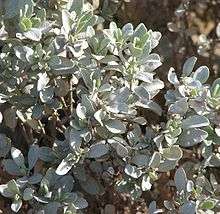Atriplex vesicaria
| Bladder saltbush | |
|---|---|
 | |
| Scientific classification | |
| Kingdom: | Plantae |
| (unranked): | Angiosperms |
| (unranked): | Eudicots |
| (unranked): | Core eudicots |
| Order: | Caryophyllales |
| Family: | Amaranthaceae |
| Genus: | Atriplex |
| Species: | A. vesicaria |
| Binomial name | |
| Atriplex vesicaria Heward ex Benth. | |
Atriplex vesicaria, commonly known as bladder saltbush, is a species of saltbush endemic to Australia.
Description
It grows as an erect or sprawling shrub up to a metre high. Leaves are oval in shape, five to 25 millimetres long, and 3 to 15 millimetres wide.[1]
Taxonomy
The species was first published by George Bentham in 1870, based on a name selected by Robert Heward.[2] The species' only synonym is Pachypharynx neglecta, published by Paul Aellen in 1938.[3]
It is a highly variable species. The Flora of Australia treatment of this species recognises eight subspecies, namely A. vesicaria subsp. vesicaria, A. vesicaria subsp. appendiculata, A. vesicaria subsp. variabilis, A. vesicaria subsp. calcicola, A. vesicaria subsp. minor, A. vesicaria subsp. incompta, A. vesicaria subsp. macrocystidia and A. vesicaria subsp. sphaerocarpa.[1] Not all of these are accepted in South Australia, where the subspecies tend to intergrade.[2]
Distribution and habitat
It occurs in arid and semi-arid areas across southern Australia,[1] growing in coastal dunes, salt pans, salt lakes, sandy plains and limestone ridges.[4]
References
- 1 2 3 Wilson, Paul G. (1984). "Chenopodiaceae". Flora of Australia, Volume 4: Phytolaccaceae to Chenopodiaceae. Canberra: Australian Government Publishing Service.
- 1 2 "Atriplex vesicaria Heward ex Benth.". Australian Plant Name Index (APNI), IBIS database. Centre for Plant Biodiversity Research, Australian Government.
- ↑ "Pachypharynx neglecta Aellen". Australian Plant Name Index (APNI), IBIS database. Centre for Plant Biodiversity Research, Australian Government.
- ↑ "Atriplex vesicaria Benth.". FloraBase. Western Australian Government Department of Parks and Wildlife.